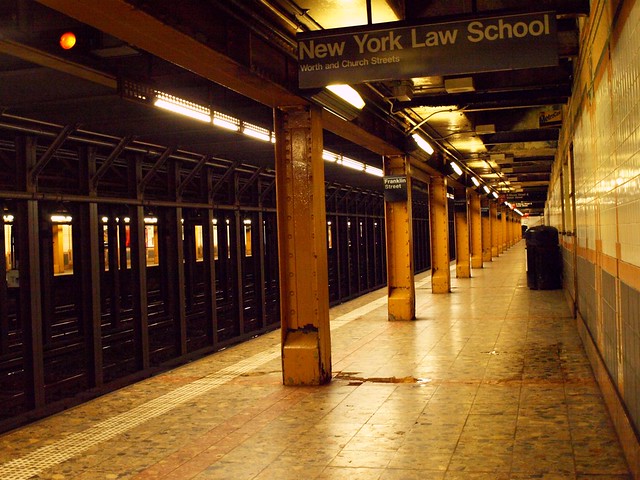
Making heads or tails of this mid-fire service change announcement requires an advanced degree in, well, something.
When I swiped through at Times Square on the way back to Brooklyn a little after 7 p.m. last night, I didn’t know what to expect. A two-alarm cable fire in a manhole near the DeKalb Ave. subway station — and the Manhattan Bridge bottleneck — snared subway service along the B, D, N, Q and R lines right as the evening rush began. For my route home, only the IRT lines were providing reliable service from Manhattan into Brooklyn, and I feared a slow, sluggish, crowded ride home.
Ultimately, I lucked out and had none of that. My 3 train was no more crowded at that hour than it ever was; we didn’t really stop for long stretches; and the conductor made nary an announcement about service outages as we rode through Lower Manhattan and Downtown Brooklyn. In fact, had I not seen word of the delays on the outdoor dynamic signs at Times Square or online, I wouldn’t have known about the service outages, and that’s a problem. But more on that later.
When I got to Brooklyn and had a chance to speak with some friends and read reports from the mayhem, it seemed that I missed quite a bit by taking the IRT. Platforms in Manhattan were packed, and the situation in Brooklyn was even worse. The MTA couldn’t scramble enough shuttle buses to meet demands, and riders were either had to walk or shove themselves onto packed buses. A parade of potential straphangers walked down 4th and 5th Aves. in Brooklyn as New Yorkers, always resourceful, took their commutes into their own hands.
Meanwhile, at Atlantic Ave., the scene was manic. Police officers were instructing confused subway riders to platforms with no service. Some officers said the R train was running when it wasn’t; others said a B or Q would arrive to ferry passengers toward Brighton Beach and Coney Island. Confused crowds built up, but eventually everyone got home.
The fire cleared up a few hours later, and the morning commute won’t be impacted. Yet, there’s another part of this story that warrants a closer examination. The MTA’s ability to deliver real-time status updates on a changing situation was again tested, and again, it didn’t really earn passing grades. On Twitter, I tried to follow along, but at various points in time, the MTA’s website featured a jumble of information. One page — available here — seems archived for posterity, and it’s not even the worst.
On the surviving page, nothing really makes sense. D trains are running along 4th Ave. in Brooklyn, but Transit also says to take the B63 to 36th St. Meanwhile, here’s a gem. Kudos to anyone who can decipher this:
Brooklyn bound N, Q and R train service will terminate at the 57 Street- 7 Avenue Station, 34 Street- Herald Square Station, the Canal Street Station and the Whitehall- South Ferry Station.
At other points, the live page said N and Q trains were running along the R from Canal St. while also saying there was no service in between Brooklyn and Manhattan on the BMT lines. It took a while for anyone at the MTA to even acknowledge the fact that service to Bay Ridge seemed nonexistent, and even after Transit announced bus routes from Downtown Brooklyn, it was still unclear if any part of the R was running out to Bay Ridge or points south. I had to ask @NYCTSubwayScoop to clear the whole thing up, and while acknowledging the mess, Transit’s official Twitter account said, “It’s a fluid situation.”
If it’s fluid for the people in charge, it’s fluid for riders too, and someone has to be able to communicate changes in real-time or as close to it as possible to riders, especially during rush hour. We’ve come along way since the MTA’s website crashed amidst a system-wide flood in August of 2007. With Twitter, a text message service and a better website, the MTA can keep its passengers informed amidst problems, but the system still isn’t perfect. If those of us who pay too much attention to the inner workings of the New York City subway system have a hard time following along, where does that leave the average rider just trying to get home from work amidst massive at 6 p.m.?











